Waterproof, full-grain leather hiking boots with aggressive tread patterns get a lot of attention when it comes to summer hiking. But those might not be the best choice for hot weather hiking or work boots. Here’s what I look for in hot weather footwear.
by Leon Pantenburg
I bought some of these boots, and others were sent for product reviews. I don’t work for any of the companies mentioned, and nobody had any input in this post. All I ever promise is a fair and impartial field testing and review.
The temperatures were in the high 90s as we set out to hike a Utah slot canyon. There was no shade in Wire Pass, and the rock canyon amplified the heat. There was no breeze. We passed other hikers wearing everything from arctic-level hiking boots to flip-flops. Many didn’t have hats for sun protection, and their small water bottles would prove to be woefully inadequate.
My wife Debbie and I were prepared for desert hiking. I wore Danner Incursions, thick Buffalo Wool socks, a broad-brimmed, mesh crown hat, a Beretta shirt and baggy shorts. I was as comfortable as could be expected for the circumstances.
Don’t think you can get by with skimpy or inadequate footwear just because it’s warm. So what should you look for in a boot that will be worn mostly in hot environments?
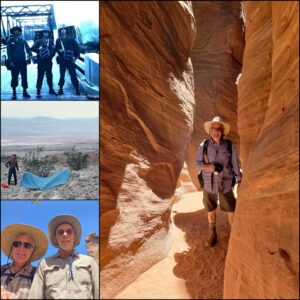
Nostalgic hot weather hiking boots: Top left: Des Moines River, Iowa, 1971, John Nerness, Michael Leiniger and me. We all wore Army surplus jungle boots. Left center: Death Valley, 1977. Lower left: John Nerness and me, 2023 Oregon high desert. Right: Slot canyon, Utah. I was wearing Danner Incursions and wool socks.
Here are my hot weather footwear preference and prejudices.
No moisture barrier: I won’t wear a boot with a waterproof liner in hot weather. My experience is that no liner can remove internal moisture (think hot, sweaty feet) as fast as it is generated. Result: moist, soft, soggy feet and hot boots. On a recent warm weather hike, Debbie was wearing her otherwise excellent Danner boots with a moisture liner.
“My feet are on fire,” she commented, about halfway through the hike. She won’t wear those boots when it’s even moderately warm. Moisture barriers have their place, but it isn’t in a hot weather boot.
At least ankle high: On unimproved trails, I always manage to kick debris into my shoes if the collar isn’t at least ankle high. On paved trails, like the Grand Canyon’s South Rim trail, I wore low cut Danner 2650s. In this case, the taller boots in the truck were not necessary, and would have been hotter. Match the footwear to the environments!
Mesh uppers: A boot has to breathe if it’s going to stay cool. Many boots today have breathable mesh just for ventilation. The jungle boots from the Vietnam era were the precursors of today’s breathable boots. The jungle boots were designed to dry out quickly under hot, humid, wet conditions. Today, they can be a good choice for the hot weather hiker.
Light colored: The color of a boot can directly affect how hot it will be. I’ve proven that to my satisfaction several times. If I’m looking for a hot weather boot, a light beige or tan color is the best choice.
Easy to lace and adjust: If it’s a bother to tighten or loosen your boots, they won’t get adjusted often. Going uphill is different from going downhill, and your feet shouldn’t be sliding around in either situation.
Get the right size: In the desert or other hot-weather hikes, the heat will make your feet swell even more than normal. If you’re shopping for boots, try them on at the end of the day, when your feet have expanded to their true size. If you’re going to be carrying a heavy pack, get them wider than normal.
I interviewed several Pacific Crest Trail end-to-enders in Bend, Oregon last summer. After some 1,500 miles, some of them needed to go to shoes about one size larger, and one size wider. Some of the women hikers went to men’s shoes because they could get a wider width.
Insulating Soles: When you’re walking on rock, pavement or asphalt on warm, sunny days, the surface temperatures can be egg-frying hot. For example, if it’s 85 degrees, then the blacktop temperature can be 110 degrees. If the air temperature is over 100 degrees, then the blacktop can reach 160 degrees. Your boot soles must insulate your feet from the ground heat.
Aggressive tread design: Or not. This depends on the terrain, and the environmental conditions. You won’t need aggressive soles on flat, desert trails. The tread may may pick up sand, adding to the boot weight with each step. Also, such treads are harder on some natural trails, and contribute to erosion.
Socks: Be very picky about what socks will go with your boots. I wear wool socks year-round. NEVER wear cotton socks in your boots. Cotton is hydrophilic, meaning it is no good at wicking wetness away from the skin, and can become damp just by being exposed to humidity. So the cotton socks will get soggy and stay that way, and your feet will get soft and possibly blister. I’ve had excellent results from Darn Tough, Buffalo Wool, Silverlight and Dechstein wool socks.
Here are some hot weather boots I have worn and recommend:
Danner Incursions and Fullbore Coyote: These boots are similar, in that they have mesh uppers, no waterproof liner and are coyote-brown colored. The Fullbore Coyotes appear to be the six-inch version of the Incursions. I have worn both pairs extensively while desert hiking over the past three years. I’ve also worn the Incursions with wool socks in cold weather deer hunting. You can’t go wrong with either of these hot weather boots.
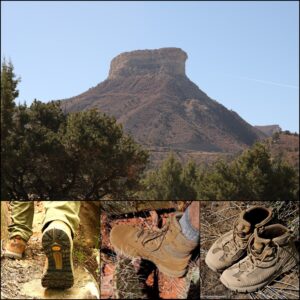
These Danner boots have proven themselves in the desert. Top: Desert mesa. Left bottom: Danner sole tread. Middle: Incursions. Right: Fullbore Coyotes.
Jungle boots: I wore jungle boots on my first long hike in 1971. At the time, there was no shopping around for different boots – I was an impoverished college student, and the boots were cheap at Ames Surplus near Iowa State University. I also wore jungle boots in 2004 on a nine-day canoe trip in the Northern Minnesota Boundary Waters Canoe area. We portaged several times a day, and the jungle boots were constantly soaked from wading and walking in mud.
During my first newspaper job with the Vicksburg Evening Post in Vicksburg, Mississippi, I frequently wore jungle boots. A newspaper reporter never knows what the day will bring – I could go from a Kiwanis club meeting in the morning, to covering a car crash, to riding in a jonboat to photograph a flood. I kept the boots polished and they didn’t look bad with a pair of slacks and a shirt and tie.
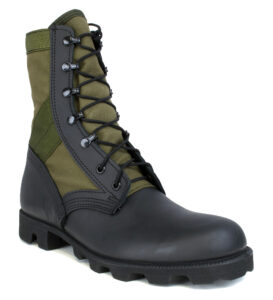
Jungle boots work well in hot, dry climates.
Danner 2650: The 2650s, named for the 2650 miles of the PCT, look like sneakers, but they are solid trail shoes. Murphy says that if you really like some product, the company will quit making it. So I bought a second pair. My wife Debbie and our friend Claudia Dencker both bought 2650s at the Danner store in Bend, Oregon. All of us swear by the 2650s.
Quick warning: The original 2650s DON’T have a moisture barrier, but some of the later models do. Make sure you get the ones that breathe.
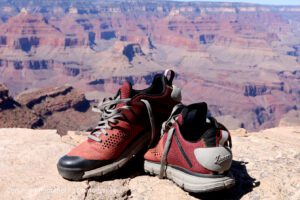
These Danner 2650s were great for hiking the south rim of the Grand Canyon.
Jim Green Ranger Boots: These unlined, full-grain leather boots are designed and made in South Africa for wildlife rangers. The boots are surprisingly cool, and the excellent soles keep your feet from slowly roasting from the ground heat. Ranger boots
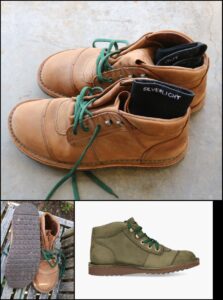
African Ranger Boots come in a variety of colors, and the barefoot models, top and left are very popular. The standard Ranger Boots, lower right, have a thicker conventional sole.
Irish Setter Ashbys: These are full-grain leather work boots, but these may be the best choice in some hot weather scenarios. The Ashbys have HRO soles, and this is a big deal for people who work on hot concrete, asphalt or on roofs. HRO Soles are designed and tested to perform on high heat surfaces and are heat resistant to melting at a minimum of 475º Fahrenheit. The leather uppers offer a lot of protection for the sides and tops of the feet. The Ashbys are a great combination of comfort and protection.
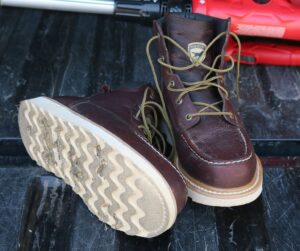
The Irish Setter Ashbys have a sole that roofers, concrete workers and pavers can appreciate.
LALO 9-inch Rapid Assault Black Ops: These just arrived and I’m wringing them out. Designed and produced by the LALO company, the acronym is short for “Light Assault Lo-Vis Operator.” In other words, they’re talking about a nimble, quick, tactical Special Forces Operator. According to the website, the boot features a unique patent including a drainage system, a composite forefoot plate, a fast-dry component and “the lightest weight materials on the market.”
So far, so good. I haven’t worn the Rapid Assault boots in the extreme heat of Arizona yet (we’re headed there in June), but the boots are proving to be comfortable in the 80+ degree Mississippi weather. The 9-inch height offers protection from ticks, chiggers and other bitey, stingy ground critters, and the drainage system is particularly attractive. As a guide for Quapaw Canoe Company, I am frequently in and out of canoes and do a lot of wading. Can’t wait to get these boots out on the Big River!
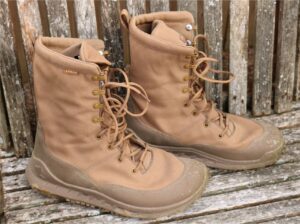
The LALO 9” Rapid Assault Black Ops boot. They come in black and sand colored.
There are a lot of factors that determine how comfortable your hiking footwear will be. Consider these things when you are shopping:
- Shoes or boots for hiking?
- Waterproof or not?
- What are the best socks for the conditions?
- How do you avoid getting sore feet?
- Will the shoes or boots keep your feet warm?
Subscribe to the SurvivalCommonSense.com YouTube channel for more how-to’s and tips on using your own good common sense.
Thanks for sharing!

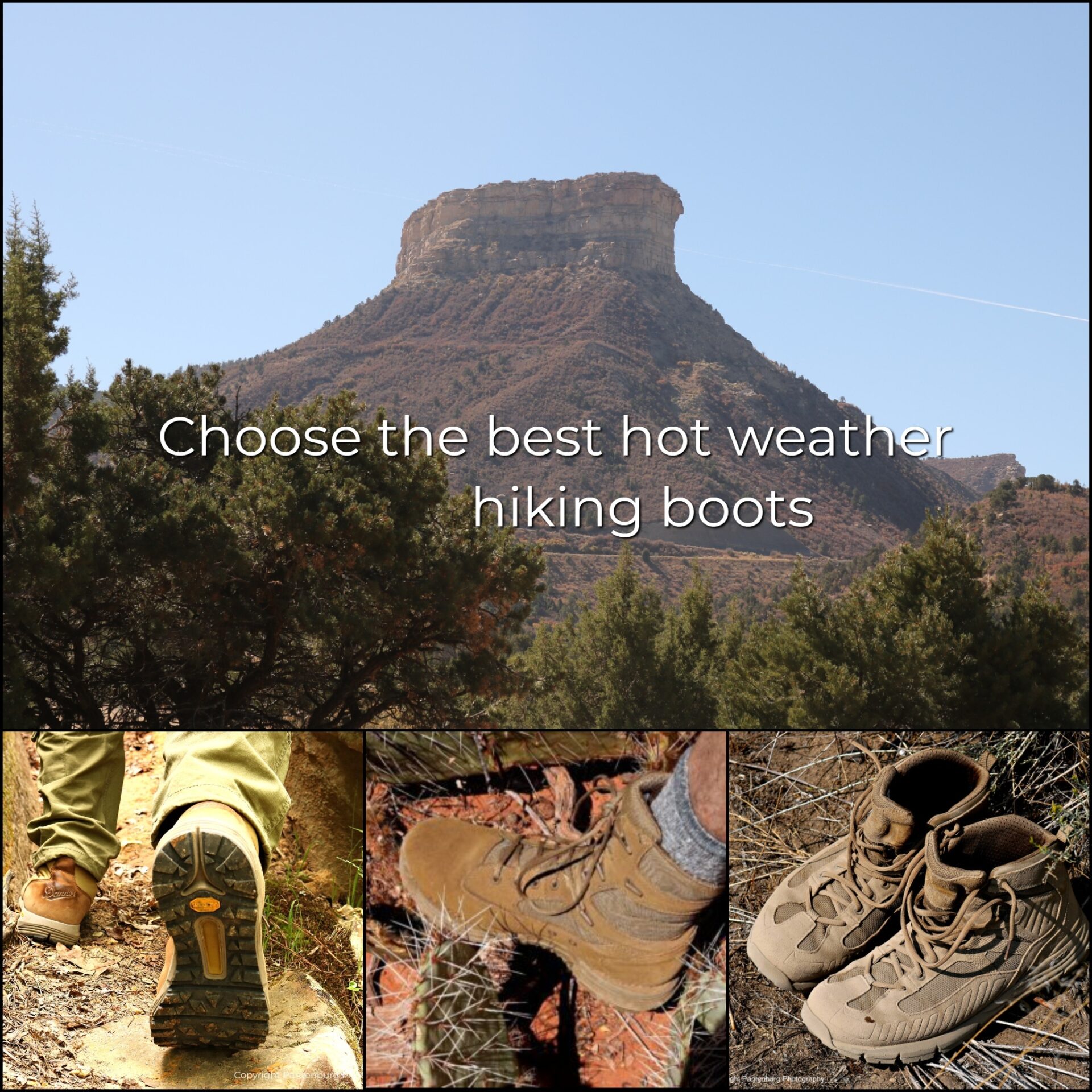

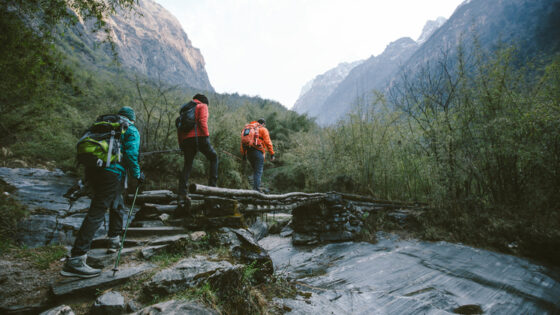
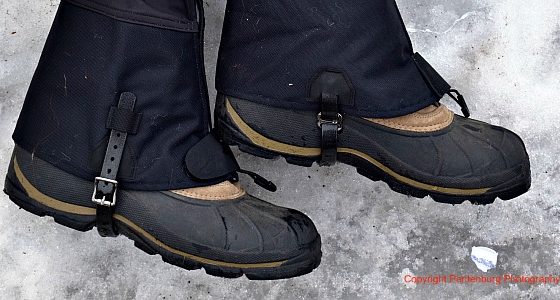
Leave a Reply